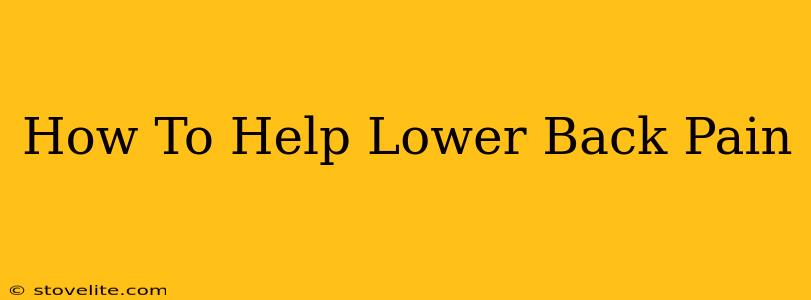Lower back pain is a pervasive problem, affecting millions worldwide. It can stem from various causes, ranging from muscle strains and sprains to more serious conditions like herniated discs. This comprehensive guide explores effective strategies to help alleviate lower back pain and improve your overall well-being. We'll cover both at-home remedies and when to seek professional medical attention.
Understanding Lower Back Pain
Before diving into solutions, it's crucial to understand the potential causes of your lower back pain. Common culprits include:
- Muscle strains and sprains: These are often caused by sudden movements, overuse, or poor posture.
- Disc problems: Herniated or bulging discs can compress nerves, causing pain that radiates down the leg (sciatica).
- Spinal stenosis: This condition involves the narrowing of the spinal canal, putting pressure on nerves.
- Arthritis: Osteoarthritis and other forms of arthritis can affect the spine, leading to pain and stiffness.
- Other conditions: Less common causes include osteoporosis, fibromyalgia, and infections.
At-Home Treatments for Lower Back Pain Relief
Many cases of lower back pain can be managed effectively at home. These strategies can significantly reduce discomfort and promote healing:
1. Rest and Ice/Heat Therapy
- Rest: Avoid activities that aggravate your pain. Rest is crucial in the initial stages of injury. However, prolonged bed rest is not recommended.
- Ice: Applying ice packs for 15-20 minutes at a time, several times a day, can help reduce inflammation and numb the pain, particularly in the first 24-48 hours after an injury.
- Heat: After the initial inflammation subsides, heat therapy (warm baths, heating pads) can help relax muscles and relieve stiffness.
2. Over-the-Counter Pain Relief
Nonsteroidal anti-inflammatory drugs (NSAIDs) like ibuprofen or naproxen can help reduce pain and inflammation. Always follow the recommended dosage and consult your doctor if you have any concerns.
3. Gentle Exercise and Stretching
- Low-impact exercise: Activities like walking, swimming, or cycling can strengthen your core muscles and improve flexibility, reducing back pain. Start slowly and gradually increase intensity.
- Stretching: Specific stretches targeting the lower back, hips, and hamstrings can help alleviate muscle tension and improve range of motion. Consult a physical therapist or healthcare professional for guidance on appropriate stretches. Examples include: Cat-cow stretch, knee-to-chest stretch, and pelvic tilts.
4. Maintain Good Posture
- Ergonomics: Ensure your workspace is ergonomically sound, with proper chair support, monitor placement, and keyboard positioning.
- Body awareness: Pay attention to your posture throughout the day. Stand tall, engage your core muscles, and avoid slouching.
5. Core Strengthening Exercises
A strong core is essential for supporting your lower back. Exercises like planks, bridges, and bird-dog stretches can significantly improve core strength and stability, preventing future back pain episodes.
When to Seek Medical Attention
While many cases of lower back pain resolve on their own, some situations require professional medical attention:
- Severe pain: Intense, unrelenting pain that doesn't respond to home remedies.
- Pain radiating down the leg: This could indicate a nerve compression, such as sciatica.
- Numbness or weakness: These symptoms can be signs of a more serious underlying condition.
- Fever or unexplained weight loss: These could indicate an infection or other serious medical problem.
- Pain lasting longer than a few weeks: If your pain persists despite home treatment, it's essential to consult a doctor.
Prevention of Lower Back Pain
Preventing lower back pain involves a holistic approach encompassing:
- Maintaining a healthy weight: Excess weight puts extra strain on your back.
- Regular exercise: Strengthening your core and improving flexibility helps prevent injuries.
- Good posture: Be mindful of your posture throughout the day.
- Ergonomic workspace: Set up your workspace to minimize strain on your back.
- Stress management: Stress can exacerbate back pain.
Disclaimer: This information is for general knowledge and does not constitute medical advice. Always consult a healthcare professional for diagnosis and treatment of lower back pain. They can accurately assess your specific condition and recommend the most appropriate course of action.

